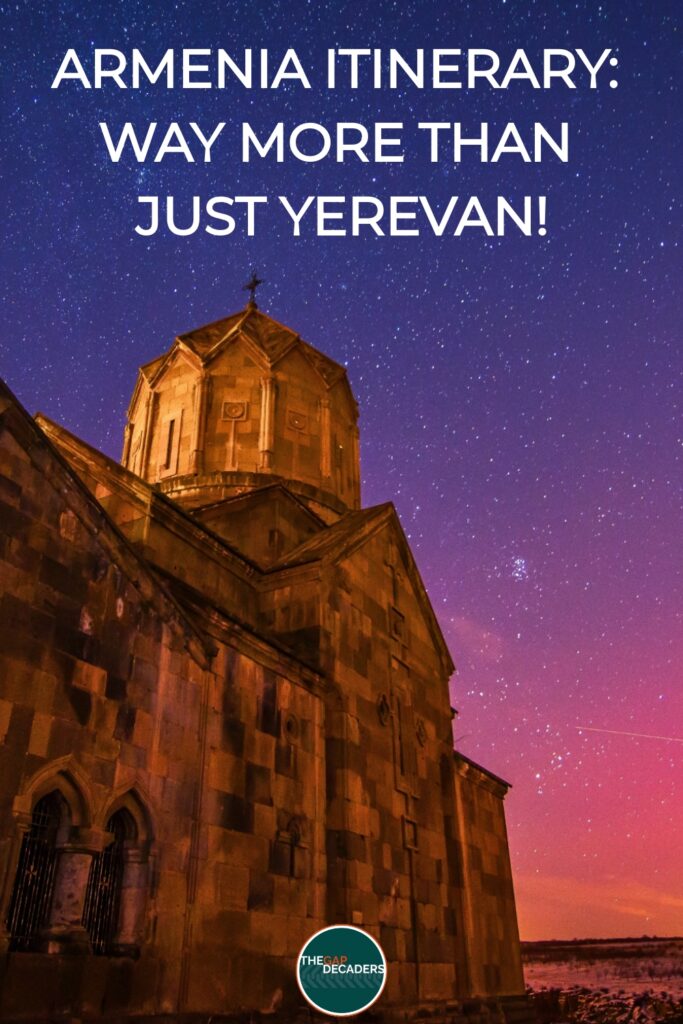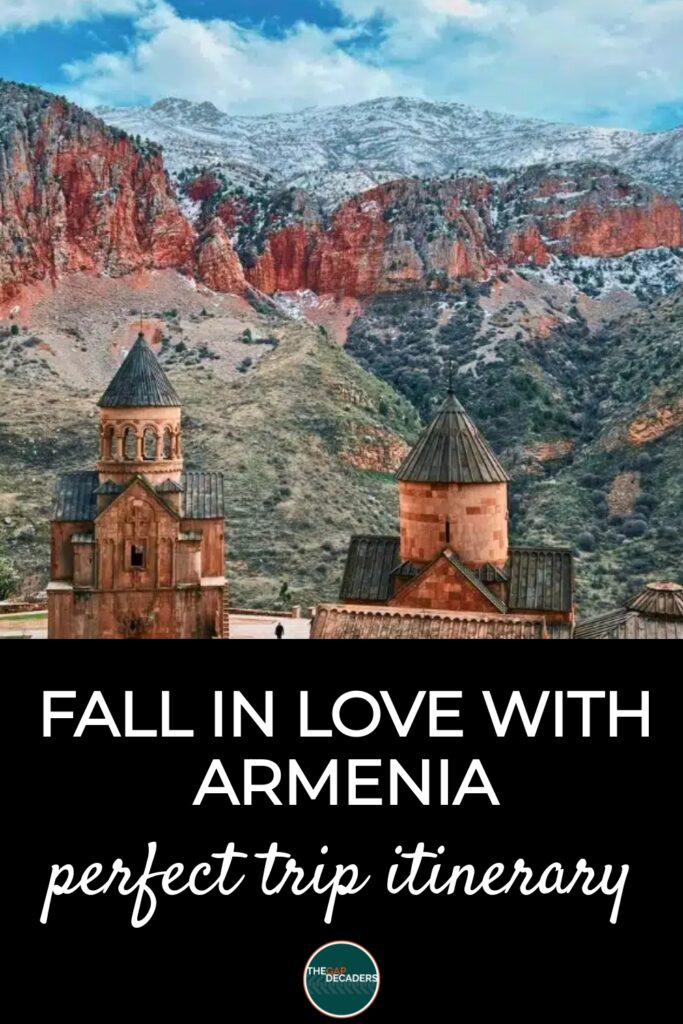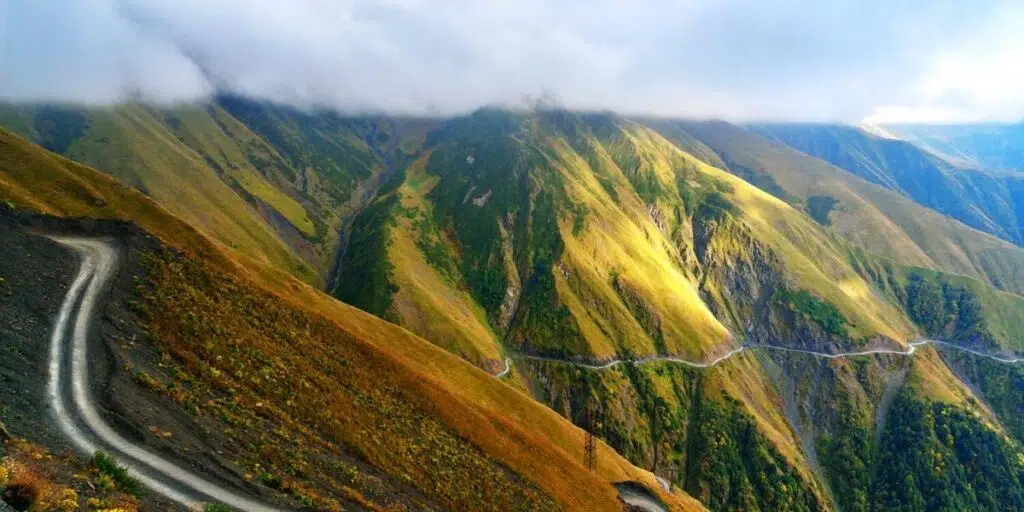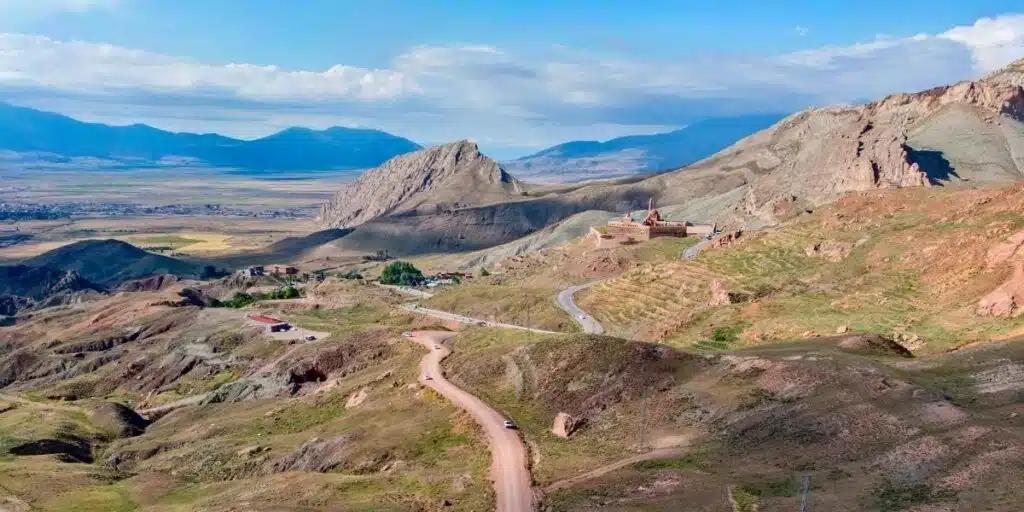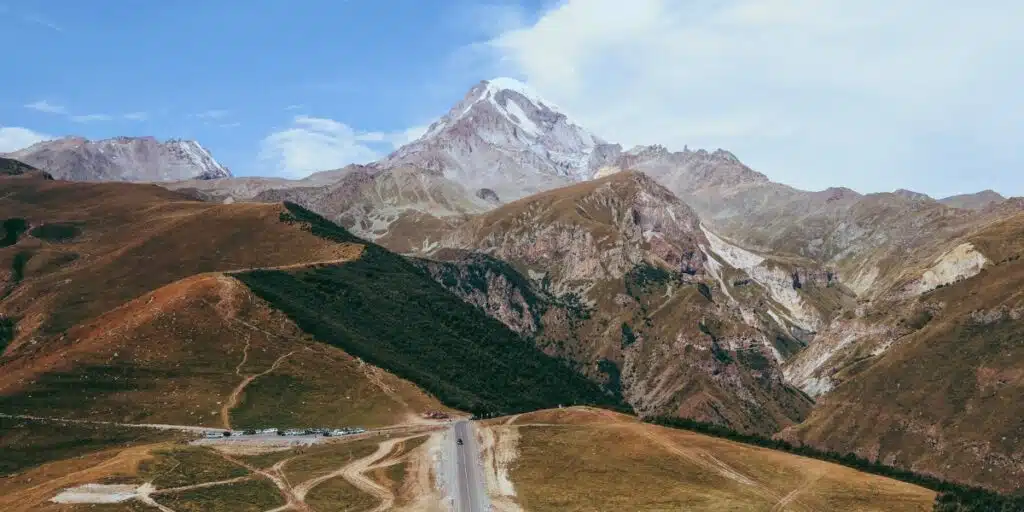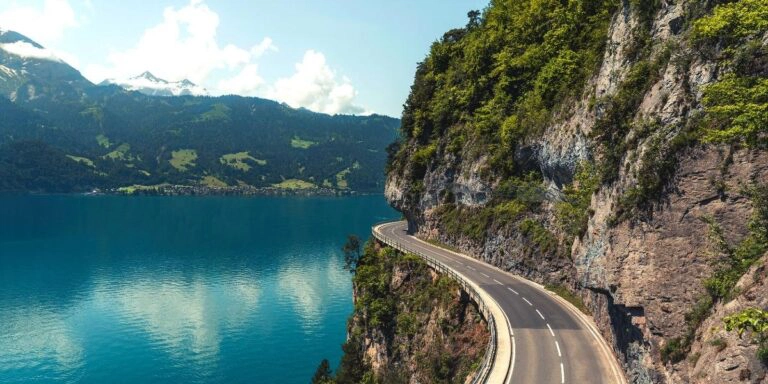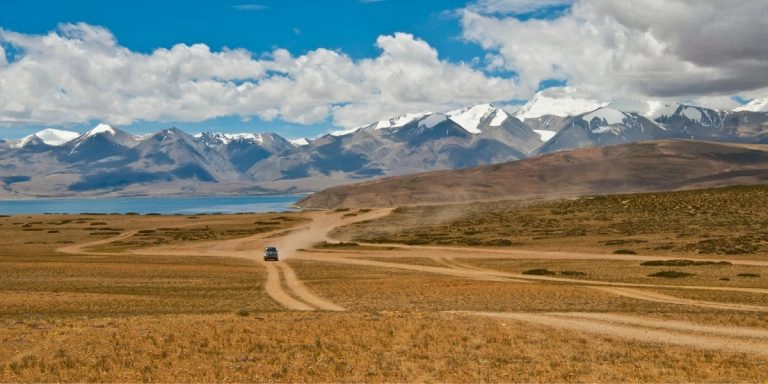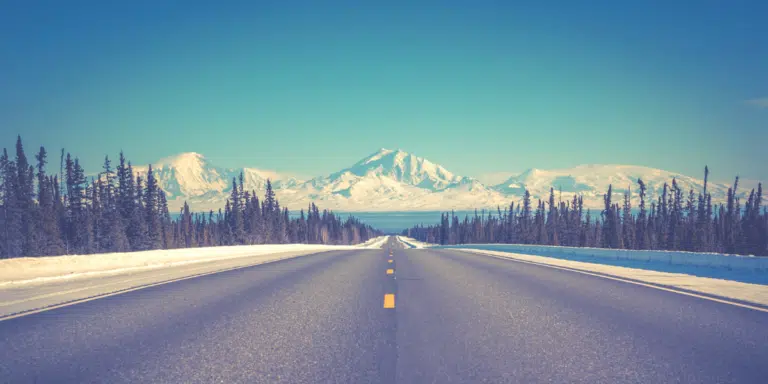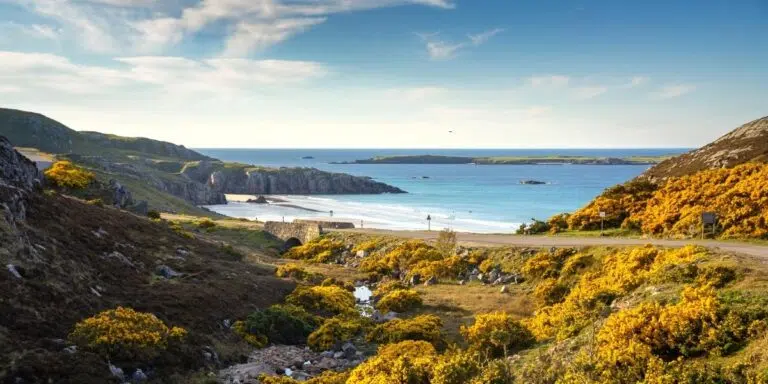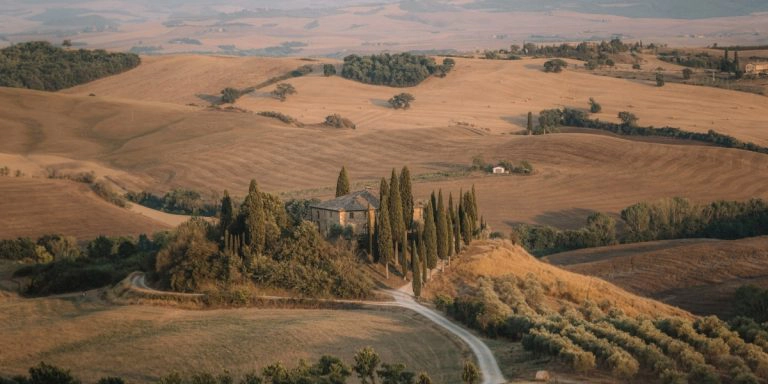This post may contain affiliate links, from which we earn an income. Click here to read our affiliate policy.
Armenia, a small yet captivating country nestled in the Caucasus offers a wealth of picturesque landscapes, ancient monasteries, and a deep-rooted cultural heritage. An Armenia itinerary promises to deliver unforgettable experiences, making the most of the country’s fascinating landmarks and history.
As you venture through Armenia, you’ll discover a blend of cultures gathered over the centuries, from Ottoman Turkey, Iran, Europe, and Soviet Russia, as well as ancient sites, spectacular natural wonders, warm hospitality and an Armenia aesthetic that feels timeless – rooted in tradition, rugged landscapes, and the enduring spirit of its people.
We spent three months exploring this tiny country that packs a real punch in terms of adventure and raw nature. In this Armenia travel guide, we’ll share the perfect Armenia itinerary, insider tips, must-see destinations, and practical advice to help you plan your own epic adventure.
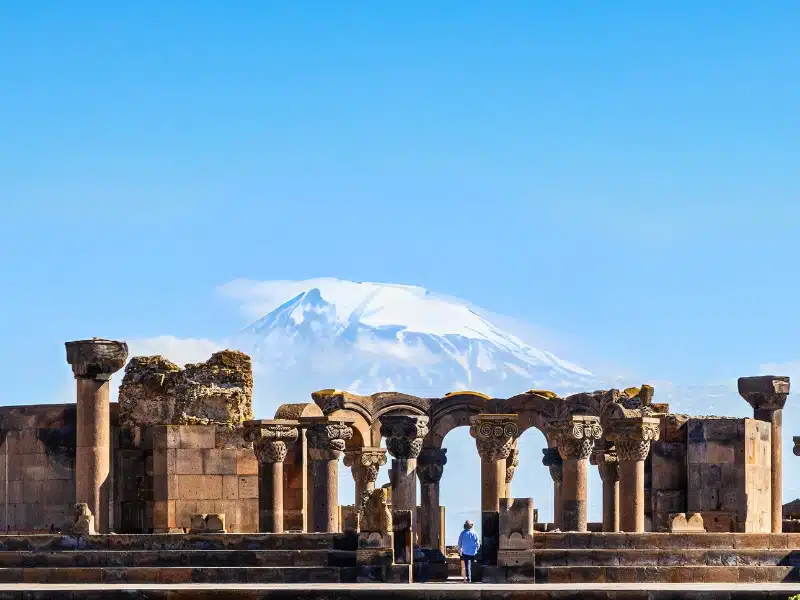
Where is Armenia?
Armenia is a landlocked country of the Caucasus region (formerly Transcaucasia) which lies south of the mighty Caucasus mountain range and neighbors the northwestern extremity of Asia. For those looking to travel Asia with a focus on its diverse cultural landscapes, Armenia offers a fascinating blend of influences. Geographically in Asia, but with cultural ties and geopolitics overwhelmingly rooted in southeastern Europe, it presents a unique crossroad worth exploring
To the north, Armenia is bordered by Georgia, to the east by the Lachin corridor, the only road that connects Nagorno-Karabakh to the Republic of Armenia under a Russian peacekeeping force, and Azerbaijan. To the southeast Armenia borders Iran, and to the west, Türkiye. The Azerbaijani exclave of Nakhchivan is to the south.
If you’re planning to travel the Caucases as a whole, the borders between Armenia and Georgia are open, but you cannot cross the land borders from Armenia or Georgia into Azerbaijan. All land borders the the country have been closed since 2020. This makes Azerbaijan travel challenging, but it is possible to fly from Tbilisi to Baku.
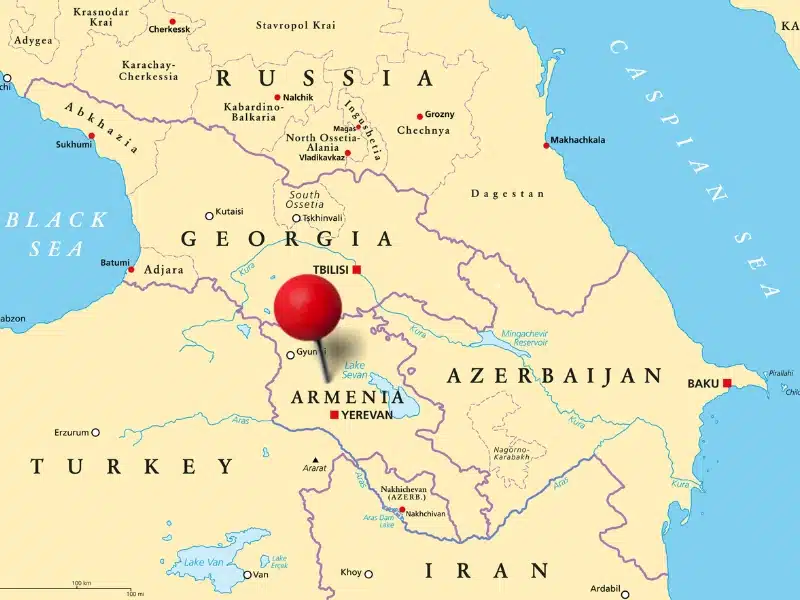
Is It Safe to Visit Armenia?
Armenia is generally safe for tourists, but like any country, visitors should take precautions to ensure their safety. Petty theft and crimes of opportunity can happen, so it’s important to keep an eye on your belongings.
Additionally, there are some political and social issues that tourists should be aware of before visiting. Check the advice from your country’s government about visiting Armenia before traveling, especially if you intend to travel near the Armenia-Azerbaijan or visit the disputed territory of Nagorno-Karabakh, due to the potential for armed conflict.
Make sure you have travel insurance you can trust when visiting Armenia. We recommend True Traveller for their 5-star TrustPilot reviews, variety of cover options, best activities cover as standard, great prices, and excellent service.
Road Trip Armenia Map & Route
This incredible 10 day itinerary from Yerevan hits all the highlights, with charming towns and cities, communist and Ottoman history, iconic monasteries, and natural wonders on the itinerary.
This Armenian itinerary will easily stretch to two weeks if you prefer to slow travel and take in more sights as you go. Why not spend longer in your favorite places, and check the interactive map for attractions and landmarks nearby?
10 Day Armenia Itinerary
How to use this Armenian road trip map – Use your fingers (or computer mouse) to zoom in and out. Click or touch the icons to get more info about a place, and click the arrow in the box top left to open the index. To add to your own Google Maps account, click the star next to the title of the map.
Day 1: Yerevan
Yerevan, Armenia’s capital city, is filled with history, art, and stunning architecture, all wrapped in a distinctive Yerevan aesthetic that blends Soviet grandeur, European elegance, and local craftsmanship. This itinerary will guide you through some of the must-visit spots in the city.
If you only have one day to spend in Yerevan, we highly recommend booking this free walking tour, where the very knowledgeable guide will take you on a three hour wander around the city, sharing history and facts about Armenian culture and history, architecture, language, food, religion, art and so much more.
If you prefer a smaller group or private tour, we recommend the highly-rated walking tour with a local guide and this Yerevan walking food tour.
Republic Square
Republic Square, located at the heart of Yerevan, is an ideal starting point for your journey. This popular site is surrounded by government buildings and historical landmarks that showcase the city’s unique ‘pink city’ architecture and is home to the dancing fountains, a choreographed light show set to music, which takes place at 9pm every evening from spring to mid-fall.
The square is also home to the mesmerizing History Museum of Armenia which holds an extensive collection of artifacts related to Armenian history. The museum features exhibits showcasing archaeological finds, ancient relics, and manuscripts, as well as displays about the different historical periods of Armenia. It is the perfect place to gain a deeper understanding of the country’s fascinating past.
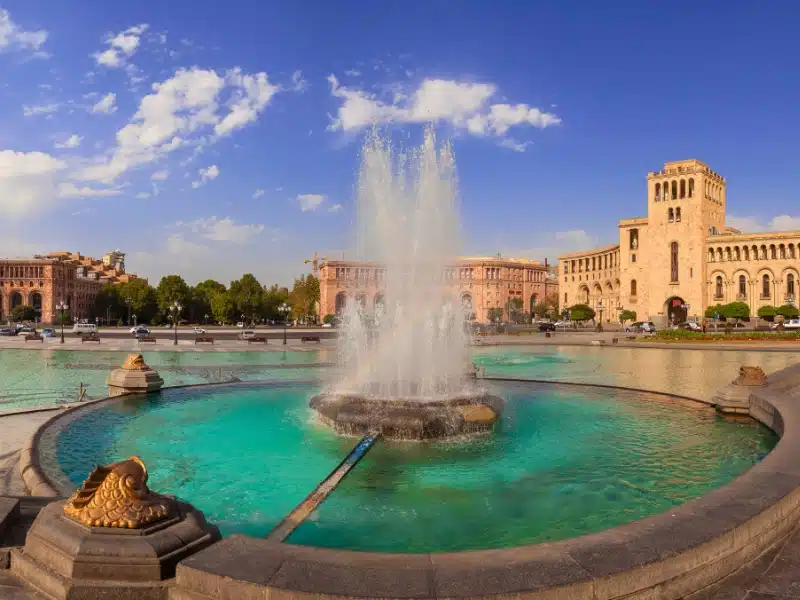
Cascade Complex
A short distance from Republic Square is the iconic Cascade Complex. This massive staircase is an architectural marvel connecting the city center to Haghtanak Park.
As you climb the 572 steps, you’ll come across beautiful sculptures, fountains, and terraces offering stunning views of Yerevan and Mount Ararat.
Inside the complex, you’ll find the Cafesjian Centre for the Arts, showcasing contemporary art exhibitions.
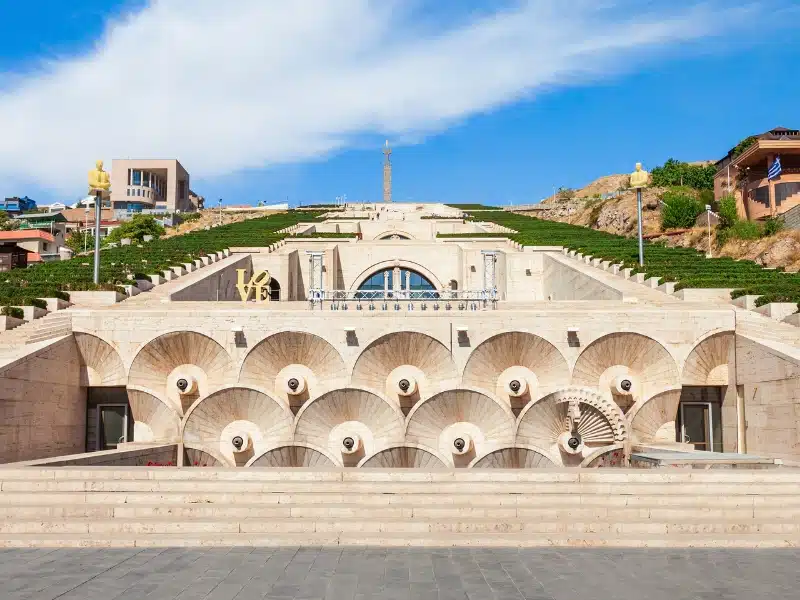
Opera House & Freedom Square
Yerevan’s Opera House, also known as Aram Khachaturian Concert Hall, is another must-visit landmark in the capital. This impressive building showcases Soviet-era architecture and is a focal point for arts and culture.
Situated next to the Opera House is Freedom Square, a popular venue for outdoor concerts, events, and gatherings. Vibrant Abovyan Street is nearby, perfect for walking and exploring the city’s cafes and shops.
Victory Park & Mother Armenia Statue
The Mother Armenia Memorial is a monumental statue in Victory Park overlooking the capital city of Yerevan, like a guardian of the Armenian capital. The statue was built to commemorate the victory of the USSR in World War II and was opened in 1950, on the 30th anniversary of the establishment of Soviet power in Armenia.
Every year on 9th May, thousands of Armenians visit the statue of Mother Armenia and lay flowers to commemorate the Armenian martyrs of the Second World War.
The pedestal hosts the Mother Armenia Military Museum of the Ministry of Defense and today, a large proportion of the exhibition space is devoted to the Nagorno-Karabakh War of 1988–1994.
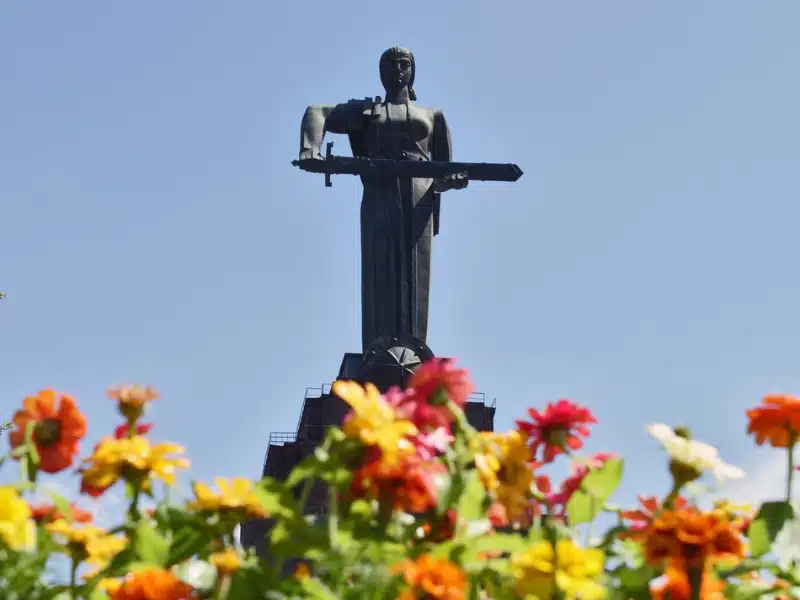
Vernissage Market
For those seeking local crafts and souvenirs, the Vernissage Market is a delightful open-air market held on weekends. Here, you’ll find a wide array of handmade items such as wood carvings, pottery, jewelry, and traditional Armenian carpets.
This bustling market is an excellent opportunity to interact with local artisans and learn more about Armenia’s rich cultural heritage.
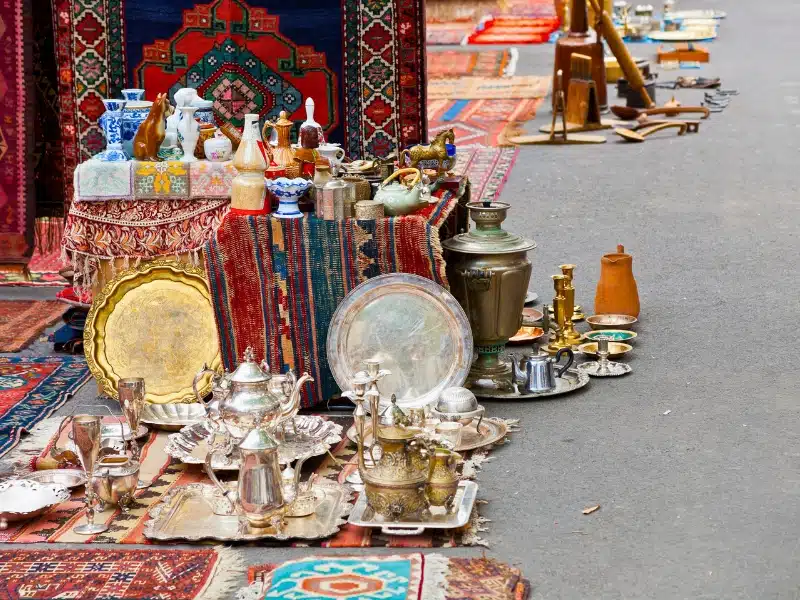
GUM Market
If food is your passion, visiting the GUM Market is a must. This indoor market, located near the Vernissage, offers an abundance of fresh fruits, dried fruits, spices, cheeses, and much more.
Locals and tourists alike flock to this market to sample traditional Armenian produce and delicacies.
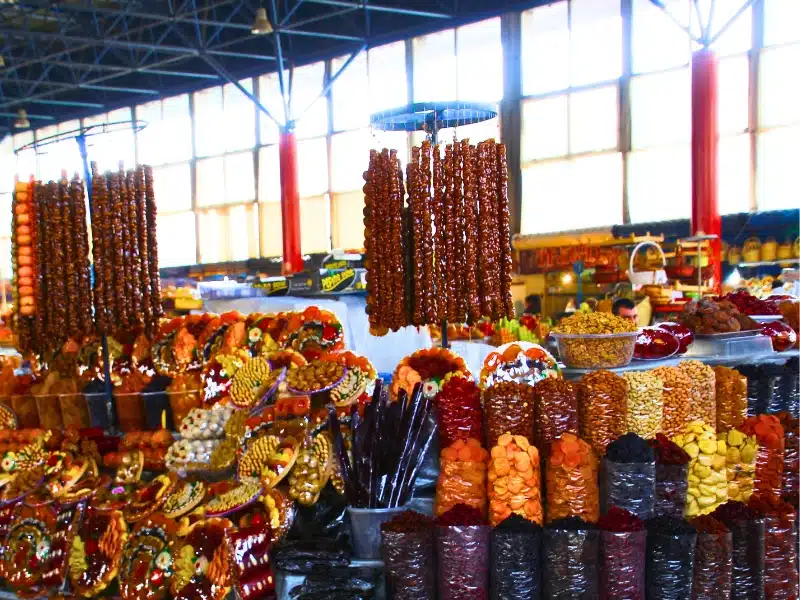
Sergei Parajanov Museum
The Sergei Parajanov Museum is a tribute to one of the most visionary and eclectic filmmakers of the 20th century. Of Armenian descent, Parajanov was renowned for his unique cinematic style, which blended surrealism, folklore, and poetic imagery.
The museum, located in a historic mansion in central Yerevan, houses a comprehensive collection of Parajanov’s artworks, including his films, collages, sculptures, and installations.
Tsitsernakaberd Memorial Complex
The memorial honors the victims of the Armenian Genocide, the systematic destruction of the Armenian people and their identity that took place in 1915. A visit to the Tsitsernakaberd Armenian Genocide Memorial Complex is an essential component of any Yerevan itinerary.
Situated on a hill overlooking the city and with distant views of Mount Ararat, the Tsitsernakaberd Memorial Complex is dedicated to the memory of the estimated 1.5 million Armenians who perished during the genocide committed by the Ottoman Empire.
Armenian Genocide Remembrance Day is observed annually on 24th April and is a public holiday in Armenia, the Republic of Artsakh, which is what Armenians call Ngorno Karabach, and the Armenian diaspora worldwide.
A visit here provides an essential historical and emotional insight into the Armenian genocide and provides visitors with a deeper understanding of the historical events and their impact on the Armenian people.
Eternal Flame & Memorial Wall
At the heart of the complex, visitors will find the eternal flame surrounded by a circle of 12 basalt slabs representing the 12 provinces of historical Armenia that were lost to Turkey during the genocide.
The flame symbolizes the resilience of the Armenian people and their ongoing quest for recognition and justice.
Adjacent to the eternal flame, a memorial wall lists the names of towns and villages where massacres took place. This provides a stark reminder of the scale of the tragedy and the loss of human life.
Armenian Genocide Museum
The Armenian Genocide Museum is an essential part of the visit to the Tsitsernakaberd Memorial Complex. Opened in 1995, the museum is dedicated to the study, documentation, and research of the Armenian genocide.
Through a series of exhibits, documents, and personal belongings, visitors can learn about the events leading up to the genocide, the perpetrators, the victims, and the aftermath.
The museum also features a library and an archive that houses numerous books, photographs, and documents related to the genocide. This wealth of information is a valuable resource for researchers, scholars, and those interested in learning more about the Armenian genocide and its lasting effects.
Where to Stay in Yerevan
Upmarket: Stay at The Alexander for its refined luxury, central location near Republic Square, and exceptional amenities, including a world-class spa and elegant dining options.
Mid-Range: Stay at Nova Hotel for its warm hospitality, stylish modern design, and convenient location within walking distance of Yerevan’s main attractions, paired with a delicious breakfast to start your day.
Budget: Stay at Moscow House Hotel for its classic elegance, peaceful ambiance, and proximity to cultural landmarks, making it an ideal base for exploring Yerevan’s rich heritage.
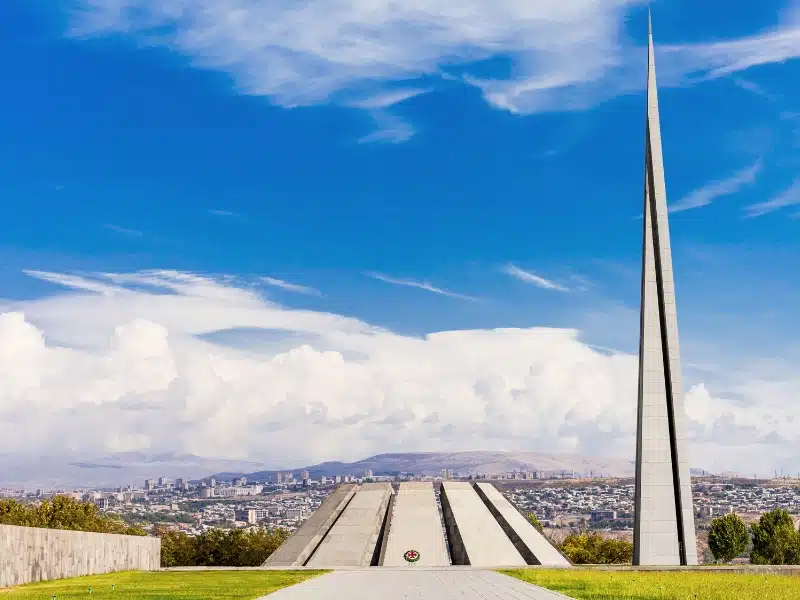
Don’t forget your road trip essentials! Our free road trip checklists help you remember everything, including road trip snacks, podcasts, and road trip songs for the journey!
Day 2: Yerevan to Alaverdi
Gyumri
A two hour drive from Yerevan is Armenia’s second-largest city, Gyumri, located in the northwestern part of the country. This under-rated city is known for its unique architecture and cultural heritage but is not really on the tourist map, which we think is a real shame.
One of the most popular tourist attractions in Gyumri is the Kumayri historic district. This area boasts some of the oldest and most unique architecture in the country, with structures dating back to the 18th and 19th centuries. Visitors can walk around the district and admire the intricate facades of the buildings, which are built using distinctive black tuff stone.
Another must-visit attraction in Gyumri is the All Saviors Church, also known as Amenaprkich Church. This church was built in the 1850s and is a stunning example of Armenian architecture. The church is located in a square surrounded by cherry trees, providing a serene and peaceful atmosphere.
In the same square to the south of the church is the 1988 Earthquake Memorial, which commemorates the 25,000 to 50,000 people killed and 130,000 injured on December 7th. The magnitude 6.8 Spitak earthquake ruptured multiple faults which lie on an active seismic belt that stretches from the Alps to the Himalayas and crosses northern Armenia.
For those interested in learning about Gyumri’s history, the Shirak Museum is a must-visit. The museum houses a collection of artifacts and exhibits that showcase the city’s rich cultural heritage. Visitors can learn about the city’s past, including its role as a trading and administrative center during the Russian Empire.
If you enjoy outdoor activities head to the Dzitoghtsyan Museum of Social Life and National Architecture. The museum is located in a beautiful park and features exhibits on traditional Armenian architecture and lifestyle.
Make sure to look west, over the Kars Highway, to spot Gyumri’s own Mother Armenia statue. If you want to get up close, it’s an easy drive or taxi ride up the hill, and you can also visit the Black Fortress, or Sev Berd, a Russian imperial fortress built during the Russo-Turkish War of 1828-1829.
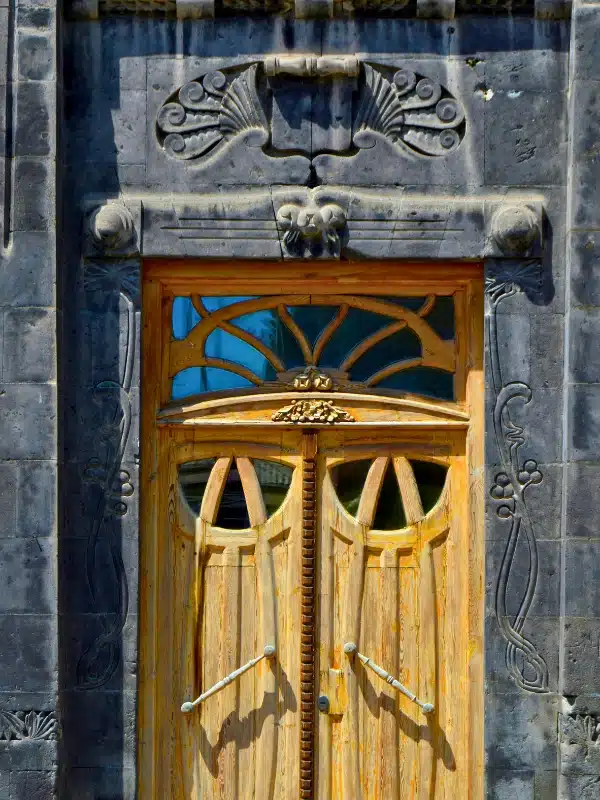
Alaverdi
A two hour drive east of Gyumri is Alaverdi, a town located in the Lori Province near the border with Georgia. An important commercial and industrial center, Alaverdi is situated at the bottom of the Debed River gorge and is the ideal base for exploring the Debed Canyon, Haghpat Monastery, and the Akhtala Monastery Fortress.
By the time you arrive, you’ll probably just want to grab some food and have a good night’s sleep before more adventures await tomorrow!
Where to Stay in Alaverdi
Mid-Range: Stay at Dream Hotel in Haghpat for its cozy atmosphere, breathtaking views of the surrounding mountains, and convenient location near the UNESCO-listed Haghpat Monastery, perfect for nature lovers and history enthusiasts alike.
Budget: Stay at Iris B&B in Debed Canyon for its charming hospitality, rustic comfort, and homemade meals, all set against the dramatic backdrop of the Debed Canyon, offering a true taste of local warmth and culture.
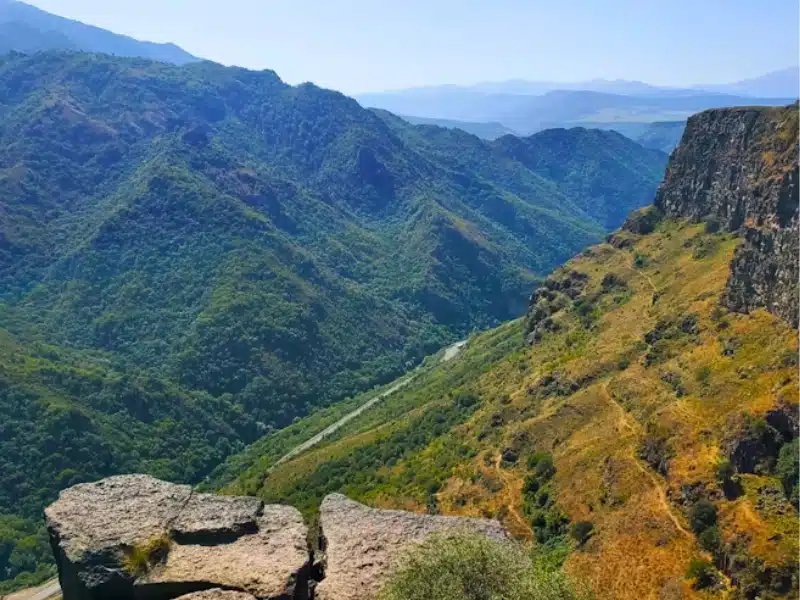
Day 3: Debed, Haghpat Monastery & Akhtala Monastery
Debed Canyon
Your first real taste of the dramatic Armenian landscape is the Debed Canyon, a stunning region known for its deep gorges, beautiful monasteries, and charming villages. As you travel from Alaverdi to the monasteries, you’ll be following the canyon of the twisting road east.
The winding river, dramatic cliffs, and lush forests that surround the road make the drive truly spectacular. If you want to explore deeper on foot, there are some great trails to check out here, but for our itinerary, we’re going to be focussing on the monasteries of the Debed Canyon.
Sanahin Monastery
The first stop out of Alaverdi, the Sanahin Monastery is just outside the town and easily accessible by car.
Founded in the 10th century, the monastery is now a UNESCO World Heritage Site. The name ‘Sanahin’ means ‘this one is older than that one’ in Armenian, referring to the fact that the nearby Haghpat Monastery was built at a later date.
The complex includes several buildings, including the main church, a bell tower, a library, and several chapels. The main church, known as the Cathedral of Sanahin, is one of the oldest surviving churches in Armenia and is known for its intricate carvings and decorations.
The bell tower, built in the 13th century, is also a notable structure, with a unique design that includes an octagonal base and a conical roof.
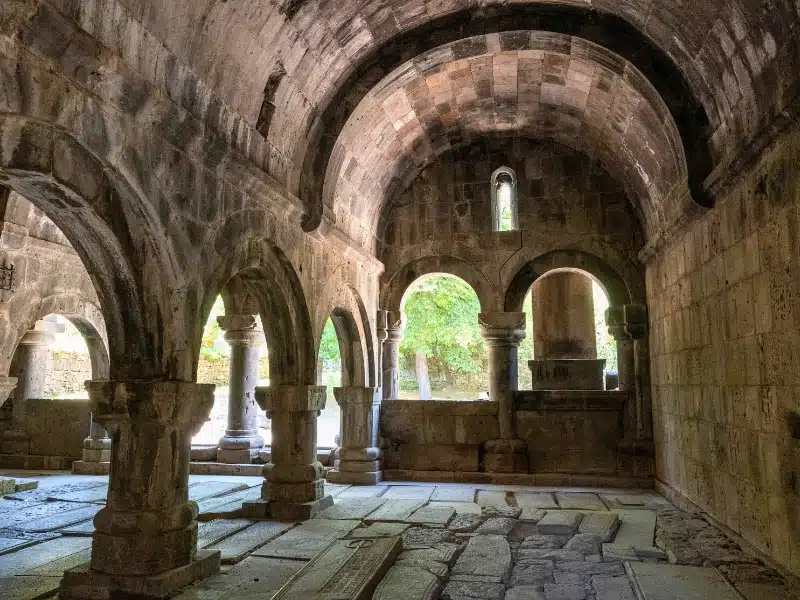
Haghpat Monastery
Haghpat Monastery, an important center of learning and culture in medieval Armenia, was founded in the 10th century and is also a UNESCO World Heritage Site.
The name ‘Haghpat’ means ‘place of games’ in Armenian, possibly referring to an ancient pagan temple that was located on the site before the monastery was built.
The complex includes several buildings, including the main church, a bell tower, a refectory, and several chapels. The main church, known as the Cathedral of Surb Nshan or Holy Sign, is a notable example of Armenian religious architecture and is incredibly atmospheric inside.
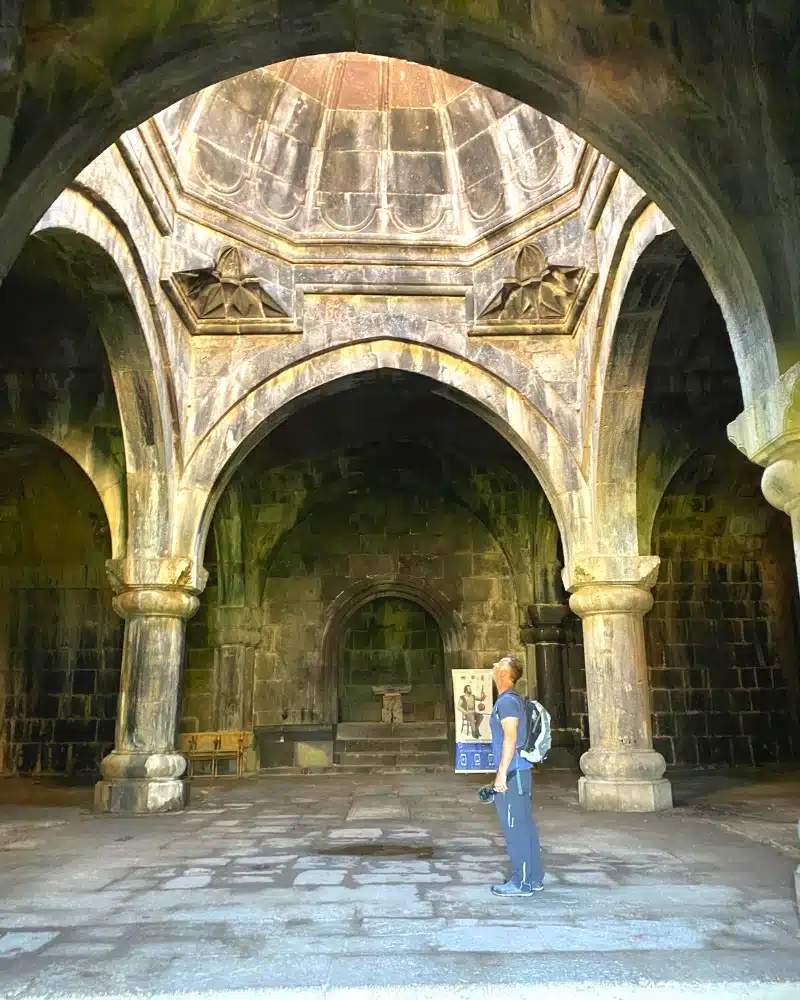
Akhtala Monastery Fortress
A 10th century Georgian Orthodox monastery, Akhtala is also known as Pghindzavank, which means ‘copper mine monastery’ in Armenian, as it was built on a site that had rich copper deposits.
The complex includes several buildings, including the main church, a bell tower, a refectory, and several chapels. The main church, known as the Church of the Holy Mother of God, is a notable example of Armenian religious architecture, with frescoes that date back to the 13th century.
Rather than drive on today, return to Alaverdi for a second night, ready for the road tomorrow.
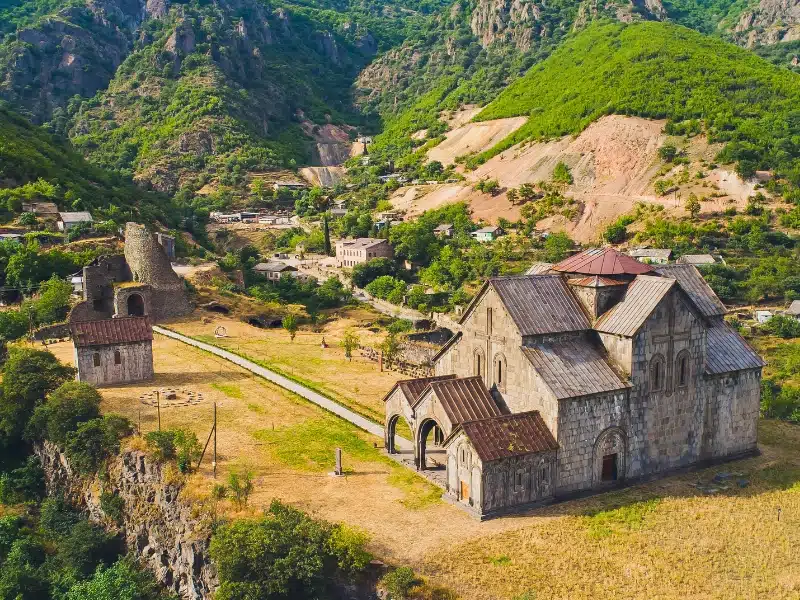
Want to plan your own road trip? Get our step-by-step road trip planning guide to help you organize the perfect trip, or check out our Europe trip ideas.
Day 4: Alaverdi to Sevan
Haghartsin Monastery
Haghartsin Monastery, which means ‘the soaring eagle’, is one of five ancient monasteries located amidst the lush forests of the Dilijan National Park.
A marvel of 10th to 13th century Armenian architecture built under the patronage of the Bagratuni Dynasty, the complex consists of three churches: St. Astvatsatsin Church (1281), St. Gregory Church (11th century), and St. Stepanos Church (1244).
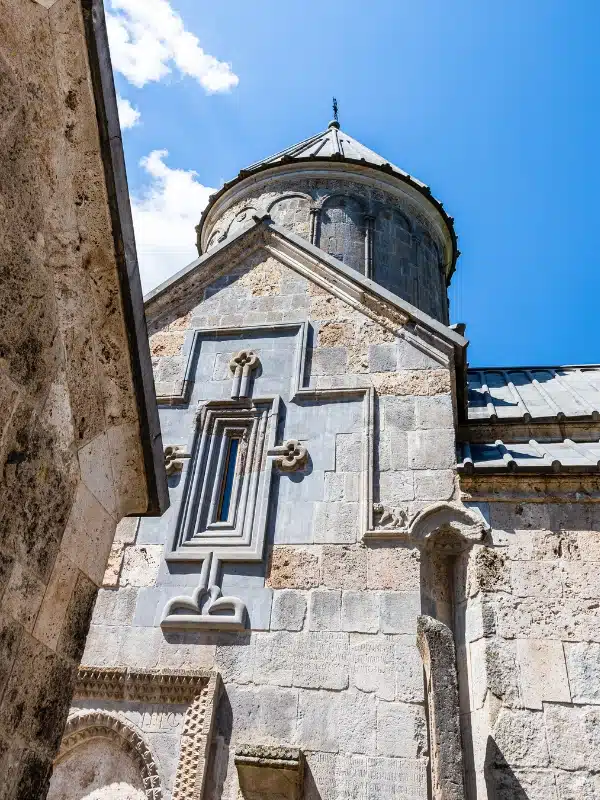
Sevan
The road to Sevan climbs steadily and has plenty of hairpin bends, tight corners, and stupendous views. There are food stalls along the road, cooking and selling whatever is in season – we ate some of the best corn on the cob we’ve ever tasted along this road!
The town of Sevan is located on the shores of Lake Sevan and is a popular summer resort for wealthy Armenians. In summer, it’s possible to swim and sunbathe on the shores and take boat trips onto the lake.
The Sevanavank Monastery is perched on a hilly peninsula near the shores of the lake and offers stunning views over the vast body of water. Originally constructed on an island in the 9th century, this religious site provides a tranquil space to soak in the natural and historical beauty of the region.
The monastery is a fifteen minute drive from town, then you have to negotiate a few steps and a street of souvenir shops, restaurants, and places where you can buy wine and oghi, which is powerful Armenian moonshine made from berries and fruit.
This was not my favorite monastery – and we visited a few! – but the exceptional khachkars or Armenian cross-stones inside and the far-reaching views of Lake Sevan made it worth the visit.
Where to Stay in Sevan
Upmarket: Stay at Sargsyan Eco House for its eco-friendly charm, serene location near Lake Sevan, and welcoming hosts who provide a homely experience with fresh, locally-sourced meals.
Mid-Range: Stay at Aragast Hotel and Brewery for its unique combination of comfortable lodging and craft beer, conveniently located by the lake, offering a relaxed atmosphere and beautiful views of Sevan.
Budget: Stay at Lavash Hotel for its lakeside setting, cozy accommodations, and delicious Armenian cuisine, all while enjoying stunning panoramas of Lake Sevan and the surrounding mountains.
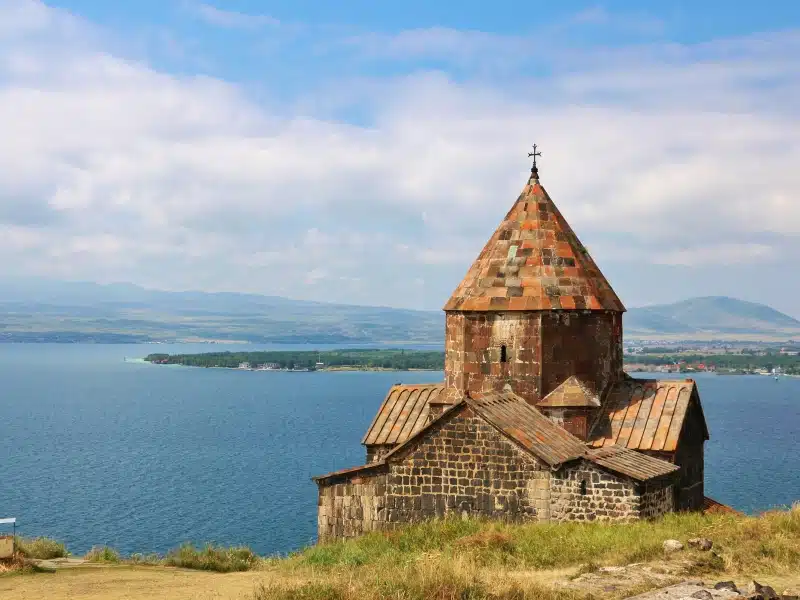
Khachkars in Armenia
A Khachkar is a carved memorial stone bearing a cross, often with additional motifs such as rosettes, interlaces, and botanical motifs. Khachkars are characteristic of medieval Christian Armenian art and have been placed on UNESCO’s Intangible Heritage list. The term Khachkar is derived from the Armenian words ‘khach’ meaning ‘cross’ and ‘kar’ meaning ‘stone’.
Khachkars can reach 4.9 feet / 1.5 meters in height and are often found in cemeteries, on roadsides, and in public squares or other community spaces throughout Armenia and have long been part of Armenia’s history to celebrate victories, to grieve, worship, commemorate, or to communicate with the eternal world.
Once the stonemason has finished carving the Khachkar there is a small religious gathering, the Khachkar is blessed and is then believed to have powers that can work towards the soul’s salvation.
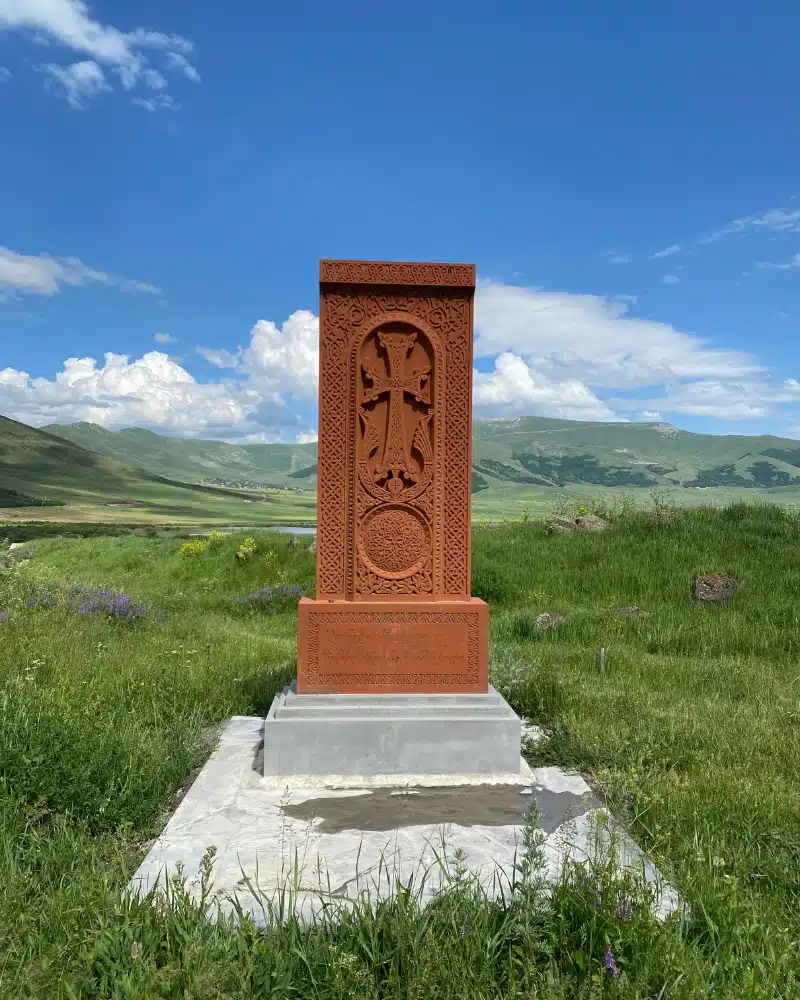
Day 5: Sevan to Yeghegnadzor
Today is all about the road, as you cross the Varden Mountains into southern Armenia. For us, this drive gave us one of the most spectacular days of scenery we had in Armenia, only topped by the drive to remote Lake Arpi in the north.
Although Google says the drive will take a little over two hours, we recommend allowing at least four hours due to the nature of some of the roads, and the speed of other traffic.
As you skirt the shores of Lake Sevan towards the mountains, you’ll really start to appreciate its size. Along the road, there are frequent stalls selling lake-caught fish, and places where you can stop and have it cooked for you.
The landscape along this route is simply glorious, especially as you start the ascent. High mountain pastures split by ribbons of water meandering through the lush vegetation flank the road before you tackle the switchbacks to the pass. There are frequent places to top up your water bottles, or fresh water tank if you’re in a camper, with cold and fresh mountain spring water.
Make sure to stop on the way to peep into the Orbelian Caravanserai on the Vardenyats Pass, 7,910 feet / 2,410 meters above sea level. Built in 1332 by Prince Chesar Orbelian to accommodate weary travelers and their animals as they crossed the mountainous Vayots Dzor region, it is the best-preserved caravanserai in the entire country.
There are usually locals in the car park selling nuts, honey, and soujuk, a delicious sausage-shaped candy made from walnuts that are dipped in a thick pomegranate or grape molasses before being strung on long strings and dried out in sunlight, which makes it crispy and crunchy.
Yeghegnadzor
Yeghegnadzor is a small town on the Srkghonk River known for its cultural heritage, including the 13th century Selim Caravanserai and the 9th century Tsakhats Kar Monastery. The town is also a popular base for wine tourism, and if you have time, you can take a tour and enjoy dinner at the excellent Old Bridge Winery.
Where to Stay in Yeghegnadzor
Mid-Range: Stay at Green Stone Boutique Hotel for its welcoming hosts, and tranquil garden setting, providing a peaceful retreat with convenient access to Yeghegnadzor’s natural and cultural attractions.
Budget: Stay at 7Rooms Boutique Hotel for its intimate, cozy atmosphere, personalized service, and elegantly designed rooms, making it a charming base for exploring the Vayots Dzor region.
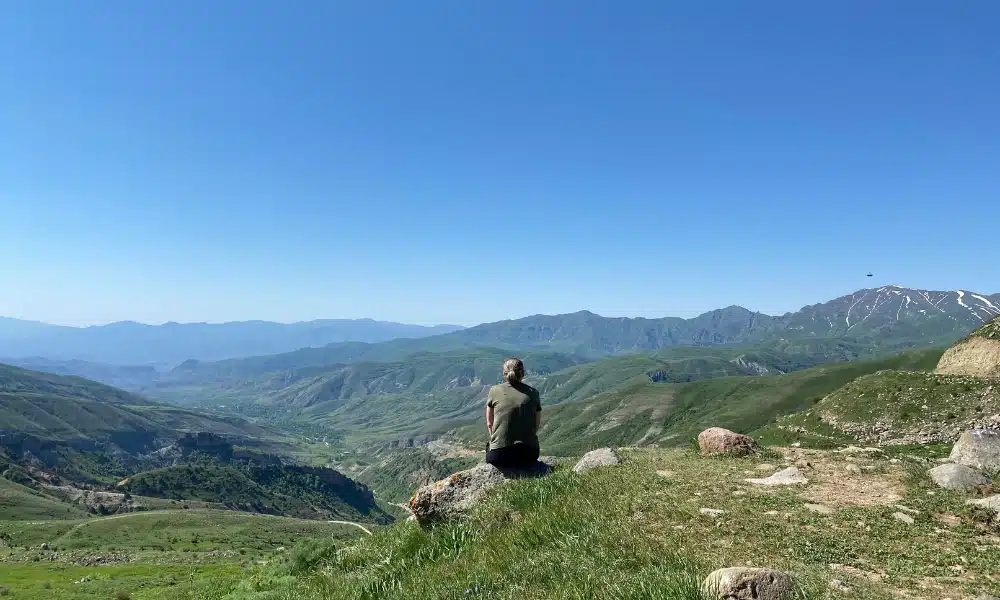
Other Nearby Road Trips
Day 6: Yeghegnadzor to Goris
Shaki Waterfall
Shaki Waterfall is a beautiful natural attraction about 6km away from the town of Sisian. The waterfall has a height of 18 meters and is situated on the left side of the Vorotan Gorge, formed by basalt lava flows over the years.
There are a couple of legends associated with Shaki Waterfall that locals will share with you. One of the legends tells the story of a conqueror who was captivated by a girl named Shaki. The conqueror ordered Shaki to come and introduce herself and gave her two options: to be his or not. Shaki chose the second option and threw herself from a high rock, causing her dress to open and transform into a waterfall.
Another legend says that a princess was once lost in the area and was found by a shepherd who fell in love with her. The princess was eventually rescued by her father, but the shepherd was heartbroken and jumped off the waterfall – possibly another version of the first legend!
The waterfall was a little underwhelming when we visited in early June, in a very hot summer. In spring, much more water will flow, and it’s possible to bathe in the pool underneath.
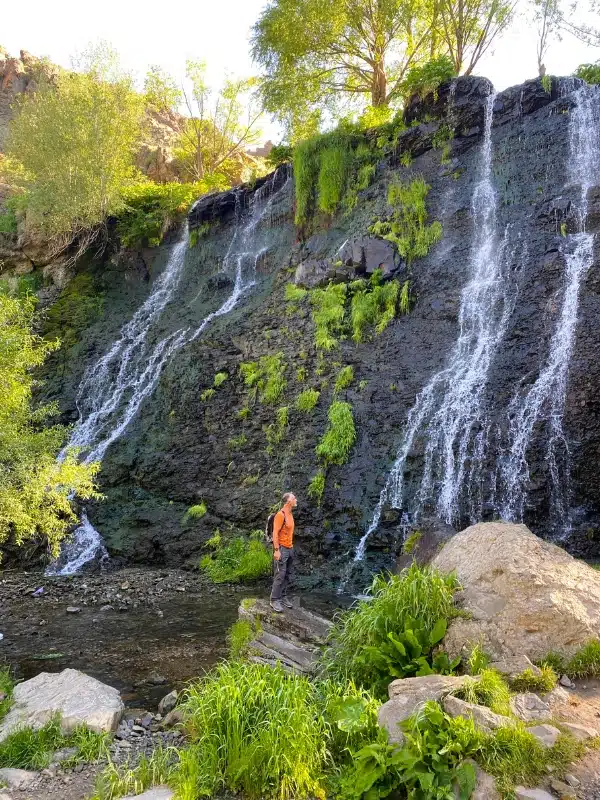
Zorats Karer
Not far from Shaki, close to the town of Sisian is Zorats Karer, also known as Carahunge and the Armenian Stonehenge. A mystic and ancient archaeological site, Carahunge is believed to be a prehistoric observatory and was one of our favorite places in Armenia.
Carahunge, which means ‘speaking stones’ in Armenian, consists of 223 stones arranged in a circle flanked by northern and southern arms and has been dated to the Middle Bronze Age. In the middle, there are about 40 stones that are formed into an ellipse. The size of the stones ranges from 0.5 to 3 meters and the heaviest can weigh up to 10 tons.
Some of the standing stones have smooth holes through them, which seem to correspond with landmarks in the surrounding landscape, like Mount Ukhtasar. The Pilgrim Mountain can clearly be seen looking north from Carahunge and is home to the Ukhtasar Petroglyphs, over 2,000 decorated rock fragments that extend to the foot of the mountain.
The Zorats Karer site covers an area of around seven hectares and Middle Bronze Age artifacts including bronze swords, fragments of beads made from antimony, and potsherds (broken piece of ceramic material) have been unearthed and traced to the first quarter of the 2nd millennium BCE.
The exact opposite of tightly controlled Stonehenge in the United Kingdom which is always busy, Carahunge was empty of other people, free to enter, and blissfully peaceful. Wandering amongst the rocks, feeling the smooth edges, holes, and lichens of the stones, and feeling the vast and wild landscape and immense history was a lesson in reverential respect.
On the opposite side of the road is a modern art performance installation called Return by the Armenian artist Ashot Avagyan which mimics Carahunge and is worth a visit.
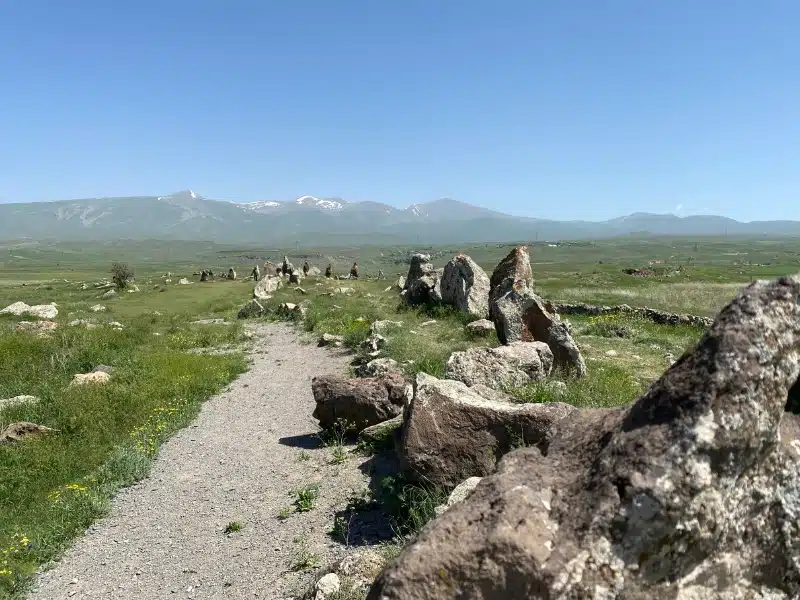
Goris
From here, make your way to Goris, a 40 minute drive east. There are several attractions to visit in Goris, including the Local Lore Museum of Goris, prehistoric cave dwellings, and Saint Gregory the Illuminator Church.
Where to Stay in Goris
Upmarket: Stay at Redroof Country House Hotel for its rustic charm, tranquil setting, and friendly service, offering a comfortable retreat surrounded by the stunning landscapes of Goris.
Mid-Range: Stay at Asour Hotel for its central location, welcoming atmosphere, and traditional Armenian hospitality, making it a convenient base for exploring Goris and its nearby attractions.
Budget: Stay at Hayi Tun Guest House for its cozy, homelike environment, warm hosts, and delicious homemade meals, providing an authentic Armenian experience in the heart of Goris.
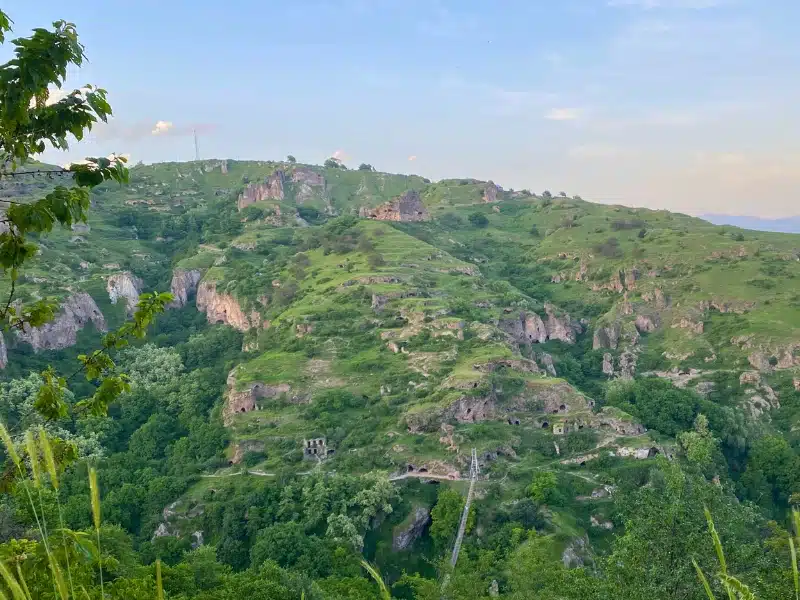
Day 7: Goris to Khndzoresk
Khndzoresk Swinging Bridge
The Khndzoresk Swing Bridge spans a dramatic gorge to the abandoned cave village of Khndzoresk, where you can explore ancient ruins and take in the fabulous views of the surrounding area.
The bridge span is 160 meters and was built by a local entrepreneur to showcase the Armenian villagers way of life. To get to the bridge you need to go down, and then back up on the return, 436 punishing steps, but it is truly worth it!
On the other side, you can explore the old cave houses and visit the tiny church in the woods surrounding the ancient village.
If you’re traveling independently, you may want to get a taxi from Goris due to the truly appalling track from the main road to the bridge, which is about 3km long. The track may not be passable in a regular car, especially if it’s been raining, and then you will definitely need a 4×4.
After you’ve finished exploring, head back to Goris for another night before driving to Tatev tomorrow.
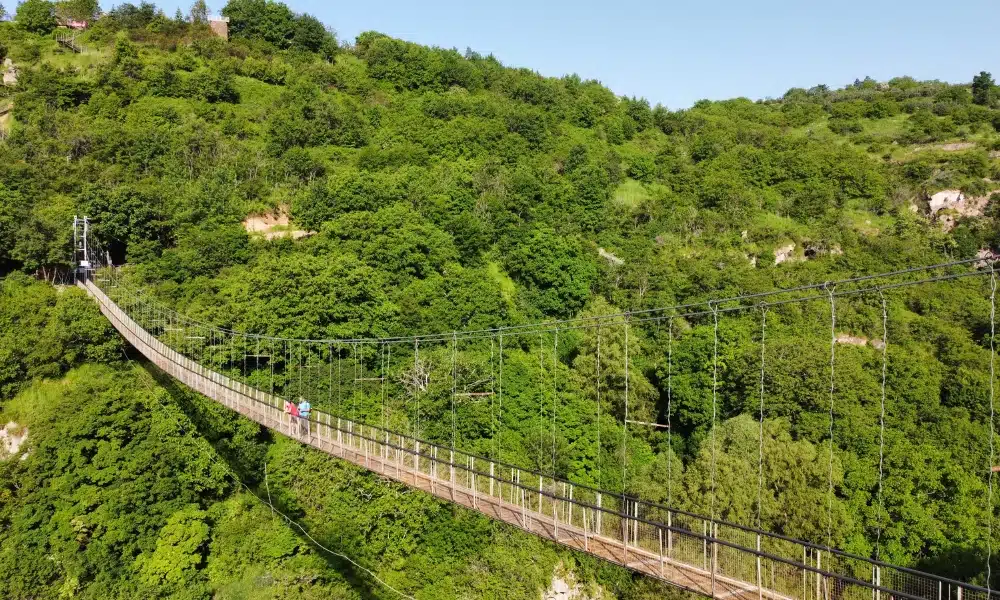
Day 8: Goris to Tatev
The Wings of Tatev & Devil’s Bridge
The Tatev Monastery is a 9th century architectural wonder perched atop a hill overlooking a stunning gorge – if ever there was an archetypal Armenian monastery, Tatev is it!
You can drive to Tatev, sometimes spelled as Tat’ev, along the incredible H45 road, crossing the Devil’s Bridge at the lowest point of the 500m gorge, before climbing to Old Tatev and the monastery. Or, you can stop north of Tatev at Halidzor and take the Wings of Tatev, the world’s longest reversible aerial tramway, which offers stunning panoramic views of the region.
Both options offer incredible views of the spectacular Vorotan Gorge, so which one should you take?
The driving option means you’ll have to drive there and back again unless you’re on a one way trip south to Azerbaijan and Iran. The Wings of Tatev cable car option costs 7000AMD (around $18) for a round trip and requires a timed booking in summer.
We did both as we were researching for this blog post, but if you can only do one, we preferred the fredom of driving and stopping to explore the Devil’s Bridge on the way.
The bridge has been created by petrified lava, which has been honed and polished by wind and water over millennia. Close to the bridge, it is possible to swim in the warm springs, which are ringed by colorful stalactites. If you’re feeling really adventurous, you can hike down to the river to see the hidden grottos below the springs.
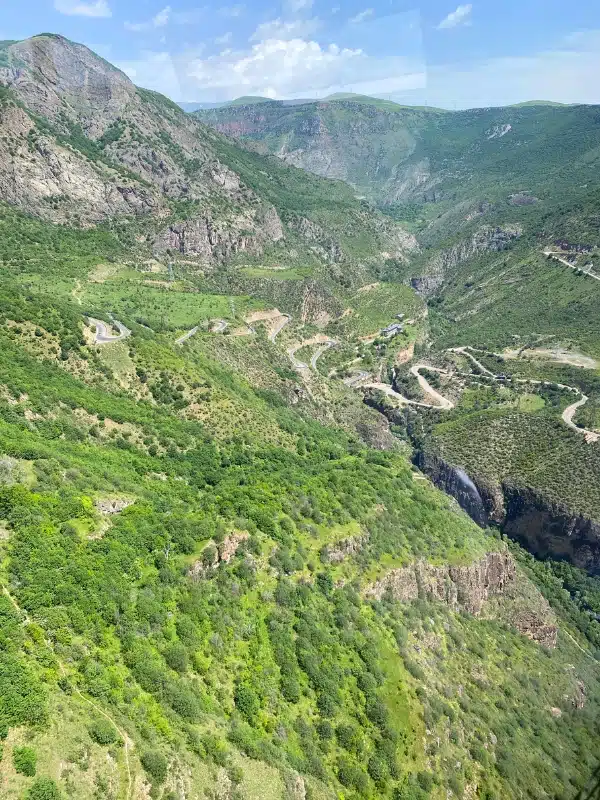
Tatev Monastery
By now, you might be feeling a bit monasteried out, we get it! But keep going, this one is really worth the effort!
Tatev Monastery is a 9th century Armenian Apostolic monastery located on a large basalt plateau on the edge of the Vorotan River gorge, the deepest gorge in Armenia at 2,788 feet / 850 meters. The whole area is a UNESCO World Heritage Site.
The main church was built in 895 by Bishop Hovhannes with the support of the Princes of Syunik. Later, in 930, the inside of the churches were carved with the beautiful frescos you can still see today. The buildings of Tatev itself date from the 9th to the 13th centuries and the monastery was a great center of science and philosophy in the medieval era.
Where to Stay in Tatev
Upmarket: Stay at Old Tatev Guesthouse for its welcoming, family-run atmosphere, traditional Armenian meals, and convenient location near the iconic Tatev Monastery, perfect for those seeking a cozy, authentic experience.
Mid-Range: Stay at Harsnadzor Eco Resort for its unique, eco-friendly wooden cabins perched on a hillside, offering breathtaking panoramic views of the Vorotan Gorge and an immersive nature experience.
Budget: Stay at Aida Bed & Breakfast for its warm hospitality, charmingly rustic setting, and hearty homemade meals, providing a comfortable and friendly base for exploring Tatev and its surroundings.
Day 9: Tatev to Areni
Areni
Today is a longer drive, of at least three hours back north. You’re heading to Areni, Armenia’s legendary home of wine.
Areni is in the heart of Armenia’s wine-producing country, with the majority of wine produced locally from the nearby village of Getap. The village is also home to the Astvatsatsin Church of Areni, a single-nave two-aisled domed Armenian church completed in the year 1321, and is located atop a plateau overlooking the village. The church is of great historical and architectural significance.
The nearby Areni-1 cave complex is the site at which archaeologists have discovered the world’s oldest winery, dating back to 4100 BC. The cave complex is also known as ‘Birds Cave’ or T’rchuneri in Armenian.
You can explore the cave and learn about the ancient winemaking techniques used by the inhabitants of the region.
After your cave trip, visit one of the many wineries nearby for a tasting session, of course! We would recommend either the intimate Momik Wines or the larger Areni Wine Factory, a name that lingers from Soviet times.
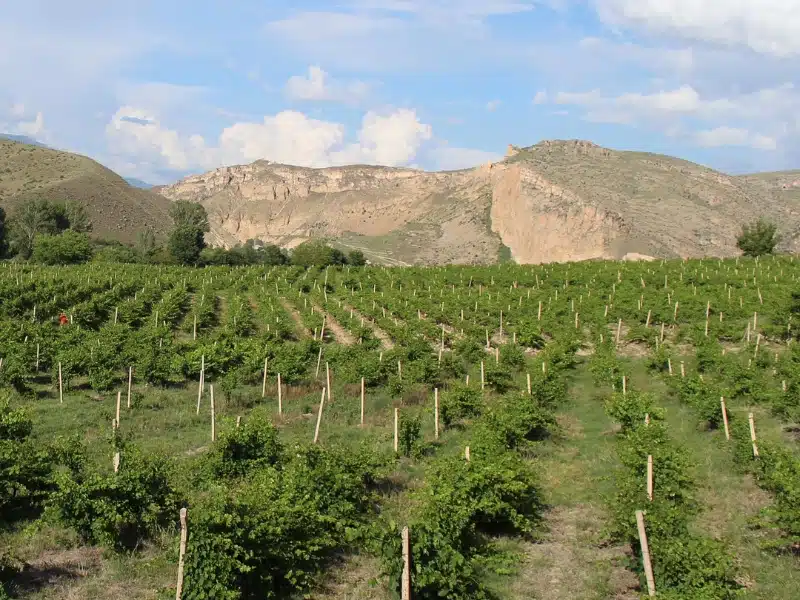
Noravank Monastery
Just 6 miles / 10km south of Areni and set amidst striking red cliffs is Noravank Monastery. Offering a unique juxtaposition of natural beauty and ancient religious architecture, the monastery features intricate carvings and frescoes, making it an essential stop as you pass through Areni.
Where to Stay in Areni
Mid-Range: Stay at Areni Lodge for its charming, vineyard-adjacent setting, welcoming hosts, and locally-produced wine tastings, providing a relaxing and authentic experience in the heart of Armenia’s wine region.
Budget: Stay at Anna Home B&B for its cozy, family-run ambiance, homemade breakfasts, and friendly hospitality, offering a warm and comfortable stay perfect for exploring Areni and its famous wineries.
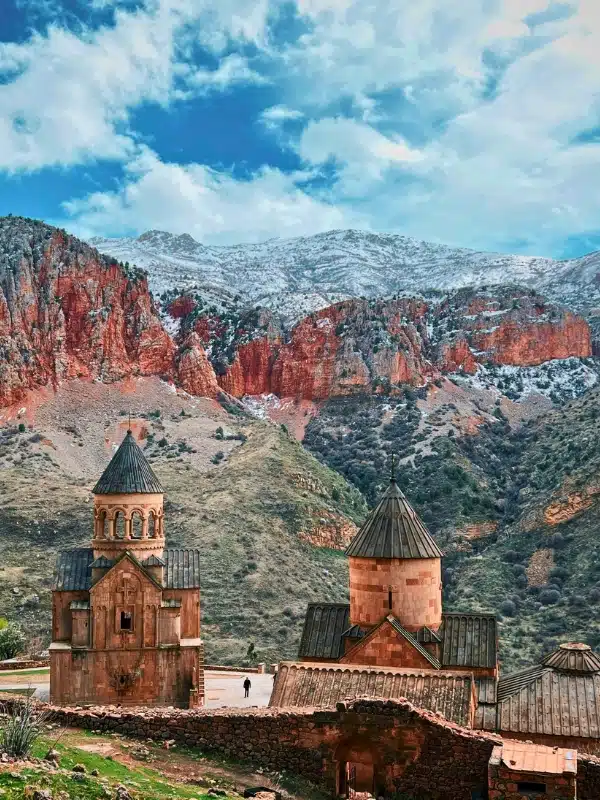
Day 10: Areni to Etchmiadzin
Khor Virap Monastery
Khor Virap Monastery is a must-visit site near Mount Ararat, right on the Turkish border. This significant pilgrimage destination once served as a prison for St. Gregory the Illuminator, the patron saint of Armenia, and offers breathtaking views of both the mountain and the surrounding landscape.
Mount Ararat, a dormant volcano, is considered to be an important symbol for the Armenian people. Although it is not in Armenia’s current territory today, it has great significance in Armenian history and culture. According to the Book of Genesis, Mount Ararat is where Noah’s Ark landed after the Great Flood, marking the beginning of a new life.
The mountains of Ararat are considered to be the cradle of Armenian civilization and are an important part of Armenian identity. In the 19th century, the peaks of Ararat represented the dreams of romantic nationalism and the goal of self-determination.
Today the meaning of Ararat is connected with the loss of territory and the pain of the Armenian Genocide. Despite being located in modern-day Turkiye, Mount Ararat remains an important cultural and spiritual symbol for the Armenian people.
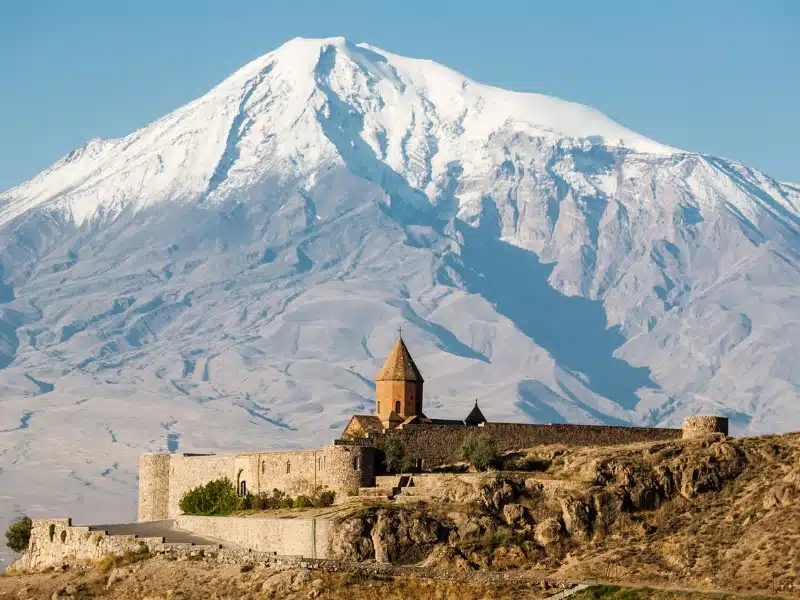
Garni Temple
The stunning Temple of Garni ia a pagan temple built in the 1st century CE and a rare example of Greco-Roman architecture in Armenia stands at the edge of a triangular cliff that overlooks the ravine of the Azat River and the Gegham mountains.
The temple is a part of the fortress of Garni, one of Armenia’s oldest, that was strategically significant for the defense of the major cities in the Ararat plain but collapsed in a 1679 earthquake. The site was excavated in the 20th century and was reconstructed between 1969 and 1975, using the original architectural elements wherever possible.
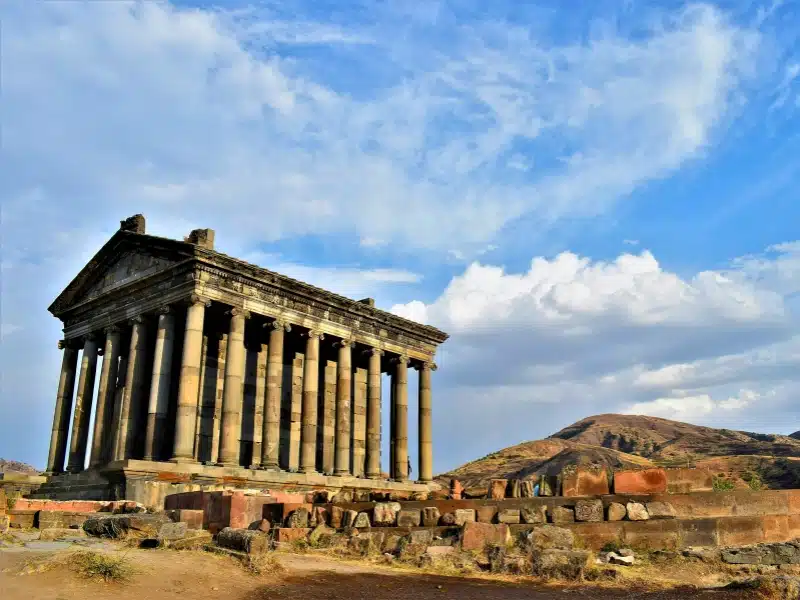
Geghard Monastery
Geghard Monastery is a medieval Armenian monastery founded in the 4th century by Gregory the Illuminator at the site of a sacred spring inside a cave. The name ‘Geghard’ means ‘spear’ in Armenian, and refers to the spear that was used to wound Jesus Christ on the cross, and was allegedly brought to Armenia by the Apostle Thaddeus to be kept at Geghard Monastery for centuries.
The monastery is partially carved out of the adjacent mountain, surrounded by cliffs, and is listed as a UNESCO World Heritage Site. The main chapel was built in 1215, and the monastery complex includes a number of churches and tombs, most of which are cut into the rock.
The complex of medieval buildings is set in a landscape of great natural beauty and is considered to be one of the most important examples of Armenian medieval architecture, showcasing an incredible mix of natural and man-made beauty.
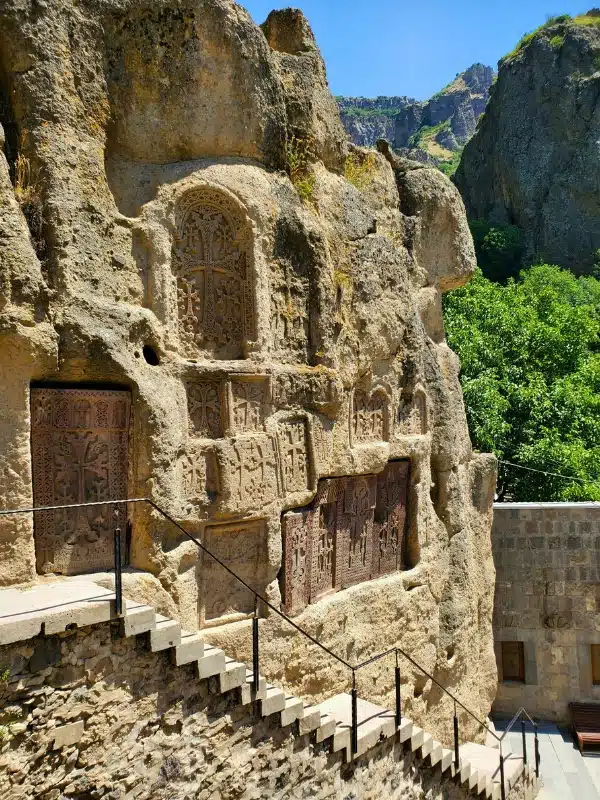
Etchmiadzin
Etchmiadzin Cathedral, also known as the Mother Cathedral of Holy Etchmiadzin, is the main cathedral of the Armenian Apostolic Church and is located in the city of Etchmiadzin.
Also known as Ejmiatsin and Vagharshapat, an ancient city founded in the 2nd century CE, Etchmiadzin is home to five UNESCO World Heritage Sites and is considered the spiritual home of the Armenian people.
Etchmiadzin Cathedral is the first cathedral built in ancient Armenia and is the largest of the city’s UNESCO sites, with the others being St. Hripsime Cathedral, St Gayane Church, Shoghakat Church and the 7th century Zvartnots Cathedral, now in ruins but still attracting worldwide attention for its imposing Ionic stone columns, topped with ornate carvings.
Etchmiadzin is easily navigatable on foot, and there are numerous museums and galleries to explore, making the city a fitting last stop on your epic Armenian itinerary.
From here, it’s an easy 40 minute drive into Yerevan, or a quick 20 minutes to the airport, which lies to the east of the city.
If you’re planning on heading north into Georgia, it will take you around 3-4 hours to reach the border. Make sure to stop and admire Mount Aragats, an isolated four-peaked volcano massif whose northern summit, at 13,419 feet / 4,090 meters above sea level, is the highest point of the Lesser Caucasus and Armenia.
Where to Stay in Etchmiadzin
Mid-Range: Stay at Najaryan’s Family House for its genuine Armenian hospitality, homely atmosphere, and delicious homemade meals, providing a welcoming base near the spiritual heart of Armenia.
Budget: Stay at Artson B&B for its friendly hosts, comfortable rooms, and convenient location close to Etchmiadzin Cathedral, perfect for travelers seeking warmth and local charm.
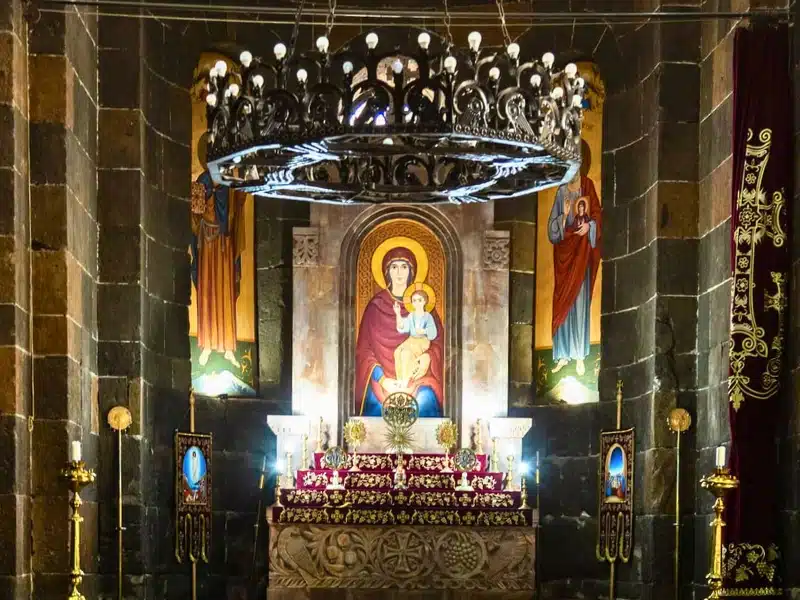
Armenia Trip Planning Resources
Getting to Armenia
Whether you’re traveling to Armenia in a car, motorcycle, or campervan from Europe, or picking up a hire car, self-driving is absolutely the best way to explore this fantastic and lesser traveled Caucasus country.
You can stop whenever you want, try new activities, visit places you see along the route, and have the freedom to change plans at the last minute.
Fly into Armenia’s Zvartnots International Airport. With direct flights from Europe, Russia, and the Middle East, it’s easy to connect with the States and the UK. We recommend booking through Skyscanner for live deals and the best prices.
Are you planning to rent a car in Armenia? We recommend hiring your car with Localrent.com, an aggregator of local car rental companies. They work with small car rental companies that only operate in their location and closely monitor the quality of their service. This means you get the best service for the lowest price.
For a real adventure, hire a campervan for an Armenia road trip. There are no specialist campervan rental companies in Armenia, so we recommend Overlando in Tbilisi, Georgia, who offer campervan rentals with their fully equipped 4×4 campers, including the awesome (and very cute) UAZ Bukhanka, a Soviet classic named after a loaf of bread!
If you prefer a smaller vehicle, check out their Lada and Hilux cars with rooftop tents. You can drive across the Georgia-Armenia border in just a few hours park and sleep anywhere along the route, as long as you’re not on private land. Use the Park4Night app to find overnight spots and campsites along the route, and check out our YouTube videos about traveling this way in Armenia!
Transportation Options in Armenia
Travel Tips & Driving in Armenia
Driving in Armenia can be challenging and is not like driving back home. Poor road conditions, road works, weather, animals, and reckless drivers create hazards aplenty, meaning you need to be clued up and switched on behind the wheel.
Whether you’re traveling in your own car, touring Armenia in a campervan or overland truck, or flying in and picking up a rental car, you need to follow these rules when you’re driving in Armenia.
Documents
- Your passport should be valid for a minimum of six months from the date you arrive in Armenia.
- You will need to carry your vehicle’s registration document, often called a ‘vehicle passport’ in Armenia.
- You must have at least 3rd party insurance for your vehicle. Your insurance company may not provide motor insurance for Armenia, in which case you can buy insurance at the border or online. The insurance is known as ‘CMTPL’ or compulsory motor third-party liability insurance and you can get prices, pay online and download your certificate from ASWA online.
- Citizens of non-EU third countries may require an International Driving Permit for driving in Armenia. You can check whether you need an IDP here.
Crossing the Border
- When entering Armenia with a vehicle, expect to pay a number of taxes. We paid around 8,500 AMD ($23) to import our overland truck. The rate seemed to be based on the value of the truck, but it wasn’t clear what we were paying for!
- Border crossings in the Caucasus can take a while, as you need to pass through passport control yourselves, have your vehicle inspected by customs, and then temporarily imported into the country. Allow at least 4-5 hours for the process.
- Make sure your documentation is in order and organize your 3rd party insurance online beforehand – it’s just one less thing to worry about on the day.
- Fixers may approach you at the crossing. It’s worth accepting their assistance because most of them can speak English, understand how things work, and have connections with the border forces. They will be happy with a small payment of $5-10 for their help.
Rules of the Road
- Armenia drives on the right and overtakes and passes on the left. Vehicles from the right and emergency vehicles have priority.
- You must carry a warning triangle by law. We also recommend that you carry at least one reflective jacket within the passenger compartment of your vehicle, a fire extinguisher, and a first aid kit.
- The drink-drive limit for all drivers is strictly 0.00%.
Tolls in Armenia
The motorway toll for foreign-registered vehicles was canceled in 2018. Previously, a fee of 10,000 AMD ($26) was charged at the border for every 15 days of stay, with longer stays having to pay more on leaving the country.
Make sure you don’t end up paying this defunct toll fee at the border!
Marshrutka Travel in Armenia
In Armenia, taking a marshrutka is a popular mode of transportation for locals and tourists alike, especially if you’re traveling Armenia on a budget. Marshrutka’s are shared minibus taxis that run on fixed routes with flexible stop locations and sometimes flexible schedules, making them a great option for budget travelers, or those without their own vehicle.
Unlike buses, marshrutkas can stop anywhere on passengers’ requests. They are generally safe and comfortable, but the quality of the vehicle and the skills of the driver can vary.
It is possible to cover the whole of this itinerary taking marshrutka from town to town. For more remote locations, you may want to book a return trip with a taxi so you can be assured of trasport.
You can find public transport and marshrutka options on the T-Armenia website, or ask your hotel or accommodation to arrange a service for you – always agree on the price in advance.
Guided Tours
Guided day trips are more organized and structured than taking public transport and you’ll be escorted at all times. You also have the advantage of knowledgeable guides who can share insights about Armenia’s culture, history, and attractions. These are our picks of the best guided day tours from Yerevan:
Best Time to Visit Armenia
Armenia is a beautiful country with a variety of attractions to explore. The best time to visit largely depends on what you want to see and do during your trip.
Generally, the months from April to June and September to October offer warm weather and pleasant temperatures, perfect for sightseeing, road-tripping, and outdoor activities.
July and August can get quite hot, indeed Yerevan is known as ‘the city of sun’ and can easily reach 40℃ / 104F in the height of summer.
The winter months bring cold temperatures and snow in higher-elevation areas, which is actually much of the country, given that Armenia’s average elevation is 5,900 feet / 1,800 meters!
RELATED POST: Things to Do in Armenia: Top Must-See Sights & Activities
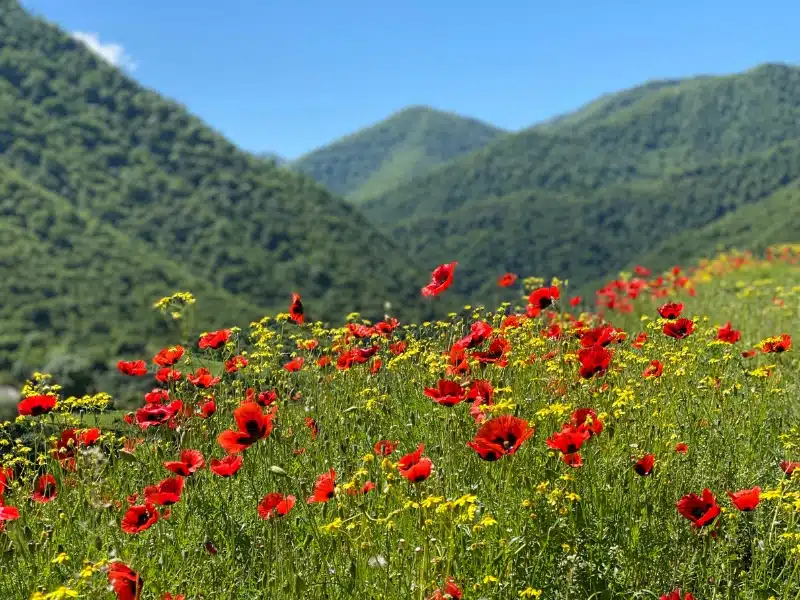
Looking for road trip inspiration? Check out these top posts…
Europe Road Trip: 25 Incredible Routes
Norway Road Trip: Four Unmissable Routes
Morocco Road Trip: An Epic Atlantic to Sahara Journey
Adventurous Road Trip – 26 of The World’s Most Exciting Routes
North Coast 500 Route Planner + Itinerary, Map & Tips
The Ultimate Bucket List Italy Road Trip
Love it? Pin it!
